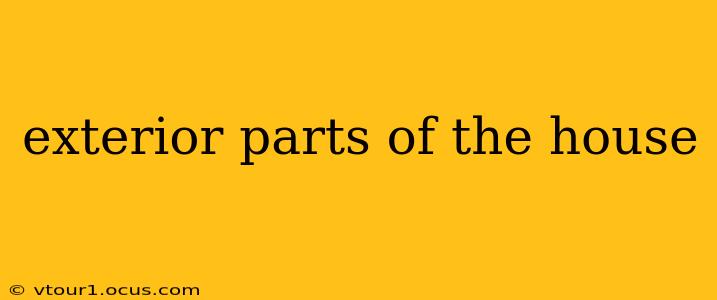The exterior of your house is more than just curb appeal; it's the first line of defense against the elements and a significant contributor to your home's overall value. Understanding its various components is crucial for maintenance, repairs, and even potential renovations. This comprehensive guide will explore the key exterior parts of a house, addressing common questions and offering valuable insights.
What are the main exterior parts of a house?
The main exterior parts of a house can be broadly categorized into structural components, cladding, and landscaping features. Let's break down each category:
Structural Components: These form the basic skeleton of your home's exterior.
- Foundation: This is the unseen but crucial base, typically made of concrete, supporting the entire structure. Its condition is vital for the stability of your home.
- Framing: The wooden or steel framework that provides the shape and support for the walls and roof. This is often covered by other exterior materials.
- Roof: Protecting your home from the elements, the roof comprises various parts like the rafters, trusses, sheathing, underlayment, and the actual roofing material (shingles, tiles, metal, etc.).
- Walls: Enclosing the living space, walls are typically constructed with framing and covered with exterior cladding.
- Windows and Doors: These provide access to the outside and natural light, while also playing a role in energy efficiency and security.
Cladding: This refers to the outer layer of material that covers the structural components, adding aesthetic appeal and protection.
- Siding: This can be made of various materials, such as vinyl, wood, brick, fiber cement, or stucco, each with its own advantages and disadvantages in terms of cost, maintenance, and durability.
- Fascia and Soffit: The fascia board is the horizontal board at the roofline, while the soffit is the underside of the roof overhang. These often house ventilation systems.
- Gutters and Downspouts: These are crucial for directing rainwater away from the foundation, preventing water damage.
Landscaping Features: While not strictly part of the house structure, these elements significantly contribute to the overall exterior appearance and functionality.
- Driveway and Walkways: Providing access to the home.
- Porch, Patio, or Deck: Outdoor living spaces.
- Landscaping (Plants, Trees, etc.): Enhancing the aesthetic appeal and potentially providing shade or privacy.
What are the different types of house siding?
As mentioned above, siding comes in a variety of materials, each with its own pros and cons:
- Vinyl Siding: Affordable, low maintenance, and comes in various colors and styles. However, it can be damaged by impact and doesn't last as long as other options.
- Wood Siding: Classic look, but requires more maintenance (painting, staining) and is susceptible to rot and insect damage.
- Brick Siding: Durable, fire-resistant, and aesthetically pleasing. However, it's more expensive than other options.
- Fiber Cement Siding: Durable, fire-resistant, and low maintenance, mimicking the look of wood. It's a more expensive option.
- Stucco: A plaster-like material that can be applied directly to the framing or over other materials. Durable and weather-resistant, but requires skilled application.
How often should I inspect the exterior of my house?
Regular inspection is key to preventing costly repairs. Aim for at least a quick visual inspection every few months, checking for any signs of damage, such as cracks, loose siding, or damaged roofing. A more thorough inspection, perhaps annually or biannually, is recommended by a professional to address potential issues before they become major problems.
What are some common exterior house problems?
Common problems include:
- Roof leaks: Caused by damaged shingles, flashing, or poor drainage.
- Cracked foundation: Can lead to structural issues.
- Rotting wood: Due to water damage or insect infestation.
- Damaged siding: From impact, weather, or age.
- Clogged gutters: Leading to water damage.
How can I improve my home's curb appeal?
Improving your home's curb appeal involves addressing both the structure and the landscaping. This might include repainting or replacing siding, cleaning or replacing gutters, landscaping improvements, or even adding features such as a new porch or walkway.
By understanding the various exterior parts of your house and performing regular maintenance, you can ensure its longevity, protect your investment, and enjoy a beautiful and functional home for years to come. Remember, proactive maintenance is always cheaper than reactive repairs.
